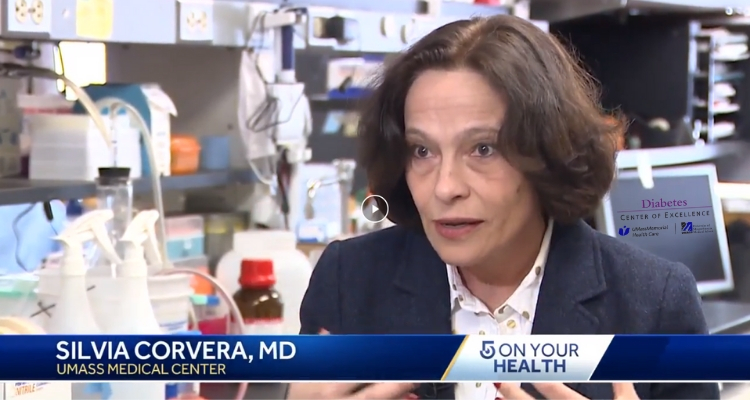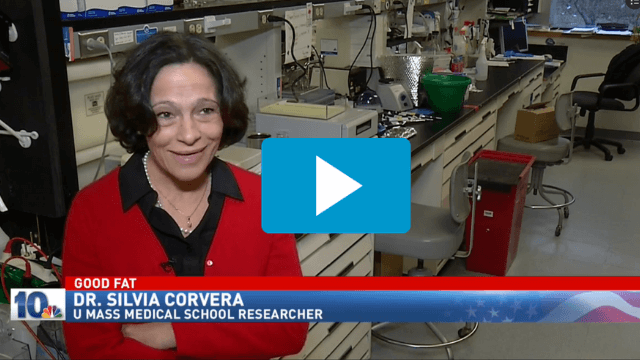Silvia Corvera, MD
Professor, Program in Molecular Medicine
Chair in Diabetes Research
UMass Chan Medical School

Type 2 Diabetes Research
Understanding the basic physiopathology of Type 2 diabetes, specifically the role of adipose tissue physiology in diabetes pathogenesis.
Current Research Highlights
- Discovered a new approach to identify and produce human adipocytes from adult adipose tissue progenitors, including those corresponding to beige/brite adipocytes with high oxidative capacity (Nat Med. 2016 Jan 25). For the first time, it is possible to generate, in-vitro, large amounts of human adipocytes that can be engrafted in humanized mice and affect systemic metabolism. Adipose tissue progenitors are amenable to genetic analysis and manipulation, and to differentiation towards chondrogenic and osteogenic lineages, allowing their use for multiple therapeutic purposes.
- Discovered that adipose tissue from obese mice and humans have a deficit in mitochondrial density which correlates with whole body insulin resistance. We found that insulin sensitizers correct the mitochondrial deficit by inducing a new class of adipocytes which have high oxidative capacity (J. Clin. Invest. 2004, 114(9): 1281-1289), now recognized to represent one of the first examples of adipose tissue beiging/browning.
- Working to translate our basic science discoveries into therapies. We envision the therapeutic use of cells derived from adipose tissue in metabolic regulation, and foresee using these cells to ameliorate complications of diabetes, such as impaired wound healing and neuropathy.
- Min SY, Kady J, Nam M, Rojas-Rodriguez R, Berkenwald A, Kim JH, Noh HL, Kim JK, Cooper MP, Fitzgibbons T, Brehm MA, Corvera S. Human 'brite/beige' adipocytes develop from capillary networks, and their implantation improves metabolic homeostasis in mice. Nat Med. 2016 Mar;22(3):312-8.PubMed PMID: 26808348. NIHMS ID: NIHMS745044.
- Wilson-Fritch L, Nicoloro S, Chouinard M, Lazar MA, Chui PC, Leszyk J, Straubhaar J, Czech MP, Corvera S. Mitochondrial remodeling in adipose tissue associated with obesity and treatment with rosiglitazone. J Clin Invest. 2004 Nov;114(9):1281-9. PubMed PMID: 15520860; PubMed Central PMCID: PMC524228.
- Rojas-Rodriguez R, Lujan-Hernandez J, Min SY, DeSouza T, Teebagy P, Desai A, Tessier H, Slamin R, Siegel-Reamer L, Berg C, Baez A, Lalikos J, Corvera S. Generation of Functional Human Adipose Tissue in Mice from Primed Progenitor Cells. Tissue engineering. Part A. 2019; PubMed PMID:30306830
Publications
A complete list of published work can be found in My Bibliography
Contributions to Science
My initial work in the field of metabolism was driven by the need to understand the membrane trafficking mechanisms that lead to insulin-stimulated GLUT4 translocation. This work led to one of the most exciting discoveries in my laboratory, which was to uncover one of the principal mechanisms by which PI-3 kinases regulate membrane trafficking. When we made this finding, a prevailing hypothesis was that PI-3 kinases were a new form of protein kinase, and their biological role could be attributable to protein phosphorylation. Using cell biological observations and proteomic approaches we discovered that the principal product of PI-3 kinase, which is the singly phosphorylated phosphoinositide PtdIns-3P, interacts specifically with a protein motif named the FYVE domain. Together with the discovery that another product of PI-3 kinase (PtdIns-3,4,5P3) interacts with the SH2 domain (another protein motif), our finding unequivocally established that the mechanism of signal transduction by PI-3 kinases consists in eliciting interactions between 3' phosphorylated phosphoinositides synthesized on the cytoplasmic surface of membranes, and cytoplasmic proteins. Given the relevance PI-3 kinases in membrane trafficking and signaling, and in cancer development, cell survival, and metabolic homeostasis, this finding was a significant contribution. This finding has also led to the identification of FYVE-domain containing proteins as pivotal factors in endosomal and phagosomal maturation, endosomal signaling, and rapid endocytic recycling.
- Hayes S, Chawla A, Corvera S. TGF-beta receptor internalization into EEA1-enriched early endosomes: role in signaling to Smad2. J Cell Biol. 2002 Sep 30;158(7):1239-49. PubMed PMID: 12356868; PubMed Central PMCID: PMC2173232.
- Patki V, Lawe DC, Corvera S, Virbasius JV, Chawla A. A functional PtdIns(3)P-binding motif. Nature. 1998 Jul 30;394(6692):433-4. PubMed PMID: 9697765.
- Patki V, Virbasius J, Lane WS, Toh BH, Shpetner HS, Corvera S. Identification of an early endosomal protein regulated by phosphatidylinositol 3-kinase. Proc Natl Acad Sci U S A. 1997 Jul 8;94(14):7326-30. PubMed PMID: 9207090; PubMed Central PMCID: PMC23820.
- Joly M, Kazlauskas A, Fay FS, Corvera S. Disruption of PDGF receptor trafficking by mutation of its PI-3 kinase binding sites. Science. 1994 Feb 4;263(5147):684-7. PubMed PMID: 8303278.
On the basis of our success in using cell biology and proteomics to uncover basic mechanisms of membrane trafficking, we used similar approaches with the goal of understanding the mechanism of action of insulin sensitizers. We discovered that Rosliglitazone, a thiazolidendione, led to induction of mitochondria biogenesis and a thermogenic phenotype in cultured adipocytes. When investigating the relevance of this finding in-vivo, we discovered a profound decrease in mitochondrial content in adipose tissue accompanying obesity and insulin resistance, which was mitigated by rosiglitazone. This finding of decreased mitochondrial content in obesity has been confirmed to occur in humans, and the effect of thiazolidendiones to elicit "browning" of adipose tissue has been confirmed by numerous groups.
- Patti ME, Corvera S. The role of mitochondria in the pathogenesis of type 2 diabetes. Endocr Rev. 2010 Jun;31(3):364-95. PubMed PMID: 20156986; PubMed Central PMCID: PMC3365846.
- Shi X, Burkart A, Nicoloro SM, Czech MP, Straubhaar J, Corvera S. Paradoxical effect of mitochondrial respiratory chain impairment on insulin signaling and glucose transport in adipose cells. J Biol Chem. 2008 Nov 7;283(45):30658-67. PubMed PMID: 18779333; PubMed Central PMCID: PMC2576555.
- Wilson-Fritch L, Nicoloro S, Chouinard M, Lazar MA, Chui PC, Leszyk J, Straubhaar J, Czech MP, Corvera S. Mitochondrial remodeling in adipose tissue associated with obesity and treatment with rosiglitazone. J Clin Invest. 2004 Nov;114(9):1281-9. PubMed PMID: 15520860; PubMed Central PMCID: PMC524228.
- Wilson-Fritch L, Burkart A, Bell G, Mendelson K, Leszyk J, Nicoloro S, Czech M, Corvera S. Mitochondrial biogenesis and remodeling during adipogenesis and in response to the insulin sensitizer rosiglitazone. Mol Cell Biol. 2003 Feb;23(3):1085-94. PubMed PMID: 12529412; PubMed Central PMCID: PMC140688.
Our biochemical and histological observations of adipose tissue from obese mice and humans indicated that a major abnormality in this tissue was a disruption in adipose tissue capillary networks. This finding was consistent with findings of marked hypoxia in adipose tissue of obese mice. Because little is known on the mechanisms by which the adipose tissue vasculature responds to the pressure of tissue expansion under conditions of over nutrition, we developed a novel in-vitro system to study adipose tissue angiogenesis and expandability. Using this assay in conjunction with gene expression studies in both mice and human tissue, we have uncovered a pivotal role of IGF-1 and IGF binding proteins in stimulating adipose tissue angiogenesis, which may be crucial for healthy expansion. This work has also led us to the identification of adipocyte progenitors within the vascular endothelium that expand in conjunction with in-vitro growth of capillary networks, and comprises a new model for the study of human adipose tissue.
1. Rojas-Rodriguez R, Lifshitz LM, Bellve KD, Min SY, Pires J, Leung K, Boeras C, Sert A, Draper JT, Corvera S, Moore Simas TA. Human adipose tissue expansion in pregnancy is impaired in gestational diabetes mellitus. Diabetologia. 2015 Jun 13;PubMed PMID: 26067361.
2. Gealekman O, Gurav K, Chouinard M, Straubhaar J, Thompson M, Malkani S, Hartigan C, Corvera S. Control of adipose tissue expandability in response to high fat diet by the insulin-like growth factor-binding protein-4. J Biol Chem. 2014 Jun 27;289(26):18327-38. PubMed PMID: 24778188; PubMed Central PMCID: PMC4140255.
3. Gealekman O, Guseva N, Gurav K, Gusev A, Hartigan C, Thompson M, Malkani S, Corvera S. Effect of rosiglitazone on capillary density and angiogenesis in adipose tissue of normoglycaemic humans in a randomized controlled trial. Diabetologia. 2012 Oct;55(10):2794-9. PubMed PMID: 22847059; PubMed Central PMCID: PMC3549462.
4. Tran KV, Gealekman O, Frontini A, Zingaretti MC, Morroni M, Giordano A, Smorlesi A, Perugini J, De Matteis R, Sbarbati A, Corvera S, Cinti S. The vascular endothelium of the adipose tissue gives rise to both white and brown fat cells. Cell Metab. 2012 Feb 8;15(2):222-9. PubMed PMID: 22326223; PubMed Central PMCID: PMC3278718.
$2.5M grant to advance potential therapy for Type 2 diabetes

Corvera Lab is collaborating with Michael Czech, PhD to investigate whether technologies developed in their labs will harness beige fat’s ability to burn energy and accelerate metabolism in order to improve the body’s response to sugar and lower blood glucose levels. LEARN MORE
The Corvera Lab is investigating how adipose tissue function during pregnancy relates to the development of gestational diabetes




